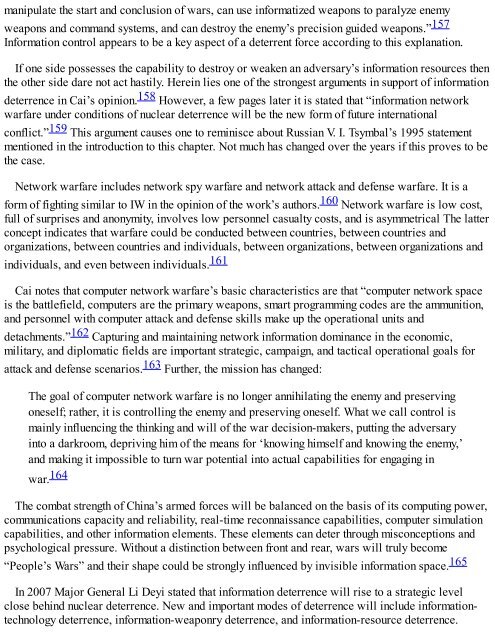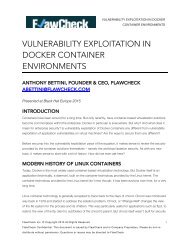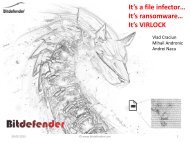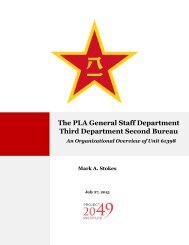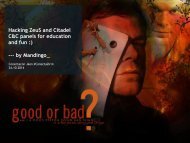3Faces%20of%20the%20Dragon
3Faces%20of%20the%20Dragon
3Faces%20of%20the%20Dragon
You also want an ePaper? Increase the reach of your titles
YUMPU automatically turns print PDFs into web optimized ePapers that Google loves.
manipulate the start and conclusion of wars, can use informatized weapons to paralyze enemy<br />
weapons and command systems, and can destroy the enemy’s precision guided weapons.” 157<br />
Information control appears to be a key aspect of a deterrent force according to this explanation.<br />
If one side possesses the capability to destroy or weaken an adversary’s information resources then<br />
the other side dare not act hastily. Herein lies one of the strongest arguments in support of information<br />
deterrence in Cai’s opinion. 158 However, a few pages later it is stated that “information network<br />
warfare under conditions of nuclear deterrence will be the new form of future international<br />
conflict.” 159 This argument causes one to reminisce about Russian V. I. Tsymbal’s 1995 statement<br />
mentioned in the introduction to this chapter. Not much has changed over the years if this proves to be<br />
the case.<br />
Network warfare includes network spy warfare and network attack and defense warfare. It is a<br />
form of fighting similar to IW in the opinion of the work’s authors. 160 Network warfare is low cost,<br />
full of surprises and anonymity, involves low personnel casualty costs, and is asymmetrical The latter<br />
concept indicates that warfare could be conducted between countries, between countries and<br />
organizations, between countries and individuals, between organizations, between organizations and<br />
individuals, and even between individuals. 161<br />
Cai notes that computer network warfare’s basic characteristics are that “computer network space<br />
is the battlefield, computers are the primary weapons, smart programming codes are the ammunition,<br />
and personnel with computer attack and defense skills make up the operational units and<br />
detachments.” 162 Capturing and maintaining network information dominance in the economic,<br />
military, and diplomatic fields are important strategic, campaign, and tactical operational goals for<br />
attack and defense scenarios. 163 Further, the mission has changed:<br />
The goal of computer network warfare is no longer annihilating the enemy and preserving<br />
oneself; rather, it is controlling the enemy and preserving oneself. What we call control is<br />
mainly influencing the thinking and will of the war decision-makers, putting the adversary<br />
into a darkroom, depriving him of the means for ‘knowing himself and knowing the enemy,’<br />
and making it impossible to turn war potential into actual capabilities for engaging in<br />
war. 164<br />
The combat strength of China’s armed forces will be balanced on the basis of its computing power,<br />
communications capacity and reliability, real-time reconnaissance capabilities, computer simulation<br />
capabilities, and other information elements. These elements can deter through misconceptions and<br />
psychological pressure. Without a distinction between front and rear, wars will truly become<br />
“People’s Wars” and their shape could be strongly influenced by invisible information space. 165<br />
In 2007 Major General Li Deyi stated that information deterrence will rise to a strategic level<br />
close behind nuclear deterrence. New and important modes of deterrence will include informationtechnology<br />
deterrence, information-weaponry deterrence, and information-resource deterrence.


